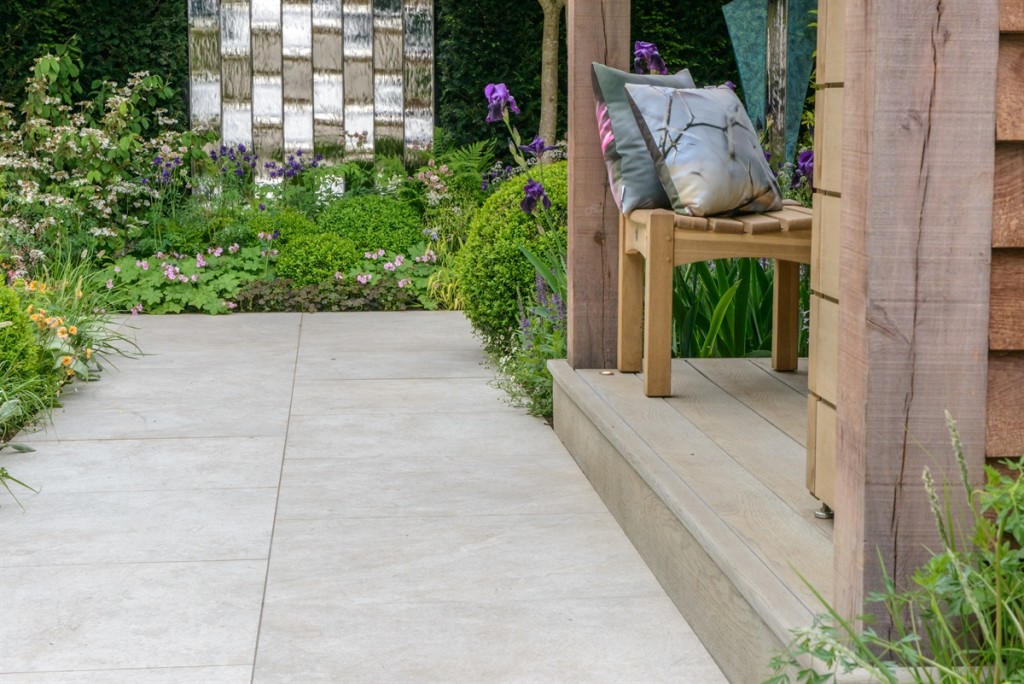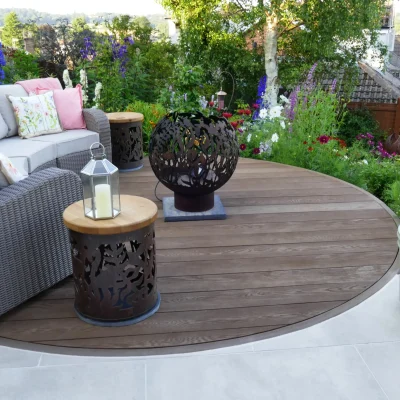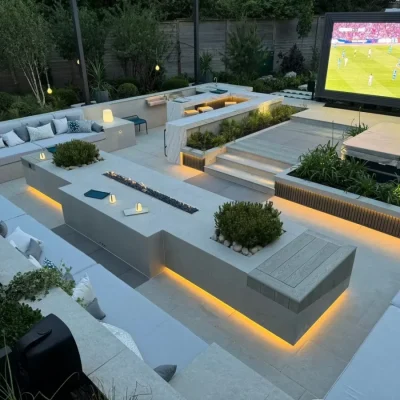The last couple of years have seen Porcelain Paving explode onto the UK market and with more and more designers and landscapers coming round to using Porcelain It looks like the material is here to stay. Despite the rise in popularity though, lots of designers and contractors are still nervous about specifying and installing Porcelain. So, what is it exactly that is holding some people back? We spoke to one of the UK’s leading Porcelain suppliers, London Stone, to get an idea of the sorts of questions that designers and landscapers are asking on a daily basis?
What’s the best way to lay porcelain?
This is the most common question and the easiest one to answer. Porcelain paving can be laid on a full bed of sharp sand and cement mortar, exactly the same as if laying natural stone. The only difference is that a primer (sometimes known as a bond bridge) MUST be used to ensure adhesion between the Porcelain and the mortar bed. This can be a dedicated slurry primer or an SBR bond bridge mixed on site.
Find out more about the right way to apply bond bridge in How to Lay Porcelain Slabs.
A lot of landscapers we speak to are also adding SBR to the mortar mix, to further aid adhesion. Following these simple steps guarantees a strong bond between the porcelain and the mortar bed.
I am struggling to cut porcelain. Any tips?
These outdoor tiles is an unbelievably hard material. In fact, it’s often said that porcelain's strength is also its biggest limitation! There is no doubt that Porcelain is difficult to cut but contractors shouldn’t be put off by this. With the right equipment Porcelain can be cut quickly and accurately. To achieve the best possible cut, Porcelain outdoor tiles should be wet cut with a specialised, continuous rim porcelain blade. Always seeking a better finish, we’re noticing that more and more landscapers are starting to use table saws to cut Porcelain with. A table saw is undoubtedly the best way to cut Porcelain and any landscaper who uses a lot of Porcelain should definitely consider investing in one.
What’s the best material to point porcelain with?
In terms of aesthetics and durability, nothing beats an exterior tile grout. Porcelain is fully rectified, so unlike natural stone there are no dimensional tolerances. The big benefit of this is that Porcelain can be laid with contemporary styled tight joints, as little as 3mm wide. Incorporating joints as tight as 3mm rules out the majority of other pointing products, so this is where exterior tile grout really comes into its own. From an aesthetics point of view Porcelain offers consistent colour and texture, so the uniform colour and smooth texture of exterior tile grout is the perfect complement.
Does porcelain need sealing?
The Italian Porcelain that we source has 0.05% porosity, so there is absolutely no point in sealing as the sealant will simply not absorb into the stone. In fact, sealing porcelain is a bad idea because the sealant will sit on the surface of the porcelain as a greasy film collecting dirt.
Is Porcelain really zero-maintenance?
Porcelain has been positioned in the UK as a low, or even by some suppliers as a no maintenance product. This is not the whole story. In reality Porcelain paving does require maintenance, especially the lighter coloured materials. The difference with Porcelain is that the low porosity of the material prevents dirt and moisture from absorbing into the material and this makes maintenance much quicker and easier.
Can Porcelain be supplied in Bespoke sizes?
Porcelain is manufactured in large batches. The ultra-efficient manufacturing process begins with the lightest colour material and runs through to the darkest coloured material. Once the darkest coloured material has been manufactured the equipment is thoroughly cleaned before the process starts again. The batch quantities usually start at around 3000m2. So unless you have an order of 3000m2, bespoke sizes are not practical. We do have our own bespoke cutting facility so if clients do need bespoke sizes we are able to cut them down from our off the shelf sizes
Can Porcelain be edge profiled?
All Porcelain can be edge profiled but achieving a quality finish is completely dependent on the quality of the base material. Some of the cheaper oriental Porcelains are not full bodied and the finished texture is printed on the upper surface only. Trying to add an edge profile to a material that is not full bodied results in an unsightly contrasting appearance between the surface texture and the freshly profiled edge. The superior European full bodied porcelain tiles carry the colour through the entire thickness of the tile, so they can be bullnosed, pencil rounded or chamfered to a high standard of finish.
Is each slab of a particular Porcelain product exactly the same?
No, there are 20 different patterns for each stone. This gives variety to each of the porcelain patio slabs within a particular product, delivering an overall colour and textural tone that blends well together whilst still showing different characteristics
Does porcelain have colour variation?
Because Porcelain is a man-made material you will not see any wild colour variation. The colour of the same product can differ slightly though depending on the conditions during the manufacturing process. Fluctuations in temperature and humidity for example can slightly effect the colour. It’s always worth checking with your supplier, particularly when ordering large quantities, that all the material you are buying comes from the same batch.
Can porcelain be installed on pedestals?
Porcelain is a very strong material. A 600x600x20mm unit will happily sit on a pedestal system without a central support pedestal. For some of the larger sizes like 1200x600 & 750x750 we would always recommend using a central support pedestal. Porcelain is used with a pedestal system extensively on roof terraces and other areas that are subject to weight restrictions.

/filters:quality(40)/mediadev/media/homepage/price_right_arrow.svg)
/filters:quality(60)/mediadev/media/menu-pics/menu_banner_mobile.png )
/filters:quality(60)/mediadev/media/menu-pics/all-porcelain.jpg )
/filters:quality(60)/mediadev/media/menu-pics/premium-italian.jpg )
/filters:quality(60)/mediadev/media/menu-pics/budget-porcelain.jpg )
/filters:quality(60)/mediadev/media/menu-pics/large-format-porcelain.jpg )
/filters:quality(60)/mediadev/media/menu-pics/wood-effect-porcelain.jpg )
/filters:quality(60)/mediadev/media/menu-pics/porcelain-planks.jpg )
/filters:quality(60)/mediadev/media/menu-pics/porcelain-setts.jpg )
/filters:quality(60)/mediadev/media/menu-pics/browse-all-paving.jpg )
/filters:quality(60)/mediadev/media/menu-pics/interior-tiles.jpg )
/filters:quality(60)/mediadev/media/menu-pics/stone-effect-porcelain.png )
/filters:quality(60)/mediadev/media/menu-pics/wood-effect-porcelain.png )
/filters:quality(60)/mediadev/media/menu-pics/grey-porcelain.png )
/filters:quality(60)/mediadev/media/menu-pics/beige-porcelain.png )
/filters:quality(60)/mediadev/media/menu-pics/dark-porcelain.png )
/filters:quality(60)/mediadev/media/menu-pics/light-porcelain.png )
/filters:quality(60)/mediadev/media/menu-pics/patio-grout.jpg)
/filters:quality(60)/mediadev/media/menu-pics/primers.jpg)
/filters:quality(60)/mediadev/media/menu-pics/porcelain-blades.jpg)
/filters:quality(90)/mediadev/media/menu-pics/drainage.jpg)
/filters:quality(60)/mediadev/media/menu-pics/cleaners.jpg)
/filters:quality(60)/mediadev/media/menu-pics/all-stone-paving.jpg )
/filters:quality(60)/mediadev/media/menu-pics/all-sawn-paving.jpg )
/filters:quality(60)/mediadev/media/menu-pics/all-riven-paving.jpg )
/filters:quality(60)/mediadev/media/menu-pics/indian-sandstone.jpg )
/filters:quality(60)/mediadev/media/menu-pics/limestone-paving.jpg )
/filters:quality(60)/mediadev/media/menu-pics/granite-paving.jpg )
/filters:quality(60)/mediadev/media/menu-pics/slate-paving.jpg )
/filters:quality(60)/mediadev/media/menu-pics/yorkstone-paving.jpg )
/filters:quality(60)/mediadev/media/menu-pics/stone-paving.jpg )
/filters:quality(60)/mediadev/media/menu-pics/stone-pavers.jpg )
/filters:quality(60)/mediadev/media/menu-pics/cobbles-setts.jpg )
/filters:quality(60)/mediadev/media/menu-pics/plank-paving.jpg )
/filters:quality(60)/mediadev/media/menu-pics/paving-circles.jpg )
/filters:quality(60)/mediadev/media/menu-pics/bespoke-paving-1.jpg )
/filters:quality(60)/mediadev/media/menu-pics/edging-stones-1.jpg )
/filters:quality(60)/mediadev/media/menu-pics/prestige-stone.jpg )
/filters:quality(60)/mediadev/media/menu-pics/grey-blue-stone.png)
/filters:quality(60)/mediadev/media/menu-pics/swatch-black-dark.jpg )
/filters:quality(60)/mediadev/media/menu-pics/swatch-buff-beige-white.jpg )
/filters:quality(60)/mediadev/media/menu-pics/sealants.jpg)
/filters:quality(60)/mediadev/media/menu-pics/all-clay-paving.jpg )
/filters:quality(60)/mediadev/media/menu-pics/alpha-clay-pavers.jpg )
/filters:quality(60)/mediadev/media/menu-pics/cottage-garden-clay-pavers.jpg )
/filters:quality(60)/mediadev/media/menu-pics/kessel-garden-clay-pavers.jpg )
/filters:quality(60)/mediadev/media/menu-pics/artisan-clay-pavers.jpg )
/filters:quality(60)/mediadev/media/menu-pics/grey-blue-clay-paver.png )
/filters:quality(60)/mediadev/media/menu-pics/red-brown-clay-pavers.png )
/filters:quality(60)/mediadev/media/menu-pics/beige-buff-clay-pavers.png )
/filters:quality(60)/mediadev/media/menu-pics/composite-decking.jpg )
/filters:quality(60)/mediadev/media/menu-pics/designboard-decking.jpg )
/filters:quality(60)/mediadev/media/menu-pics/classic-designboard.jpg )
/filters:quality(60)/mediadev/media/menu-pics/brushed-designboard.jpg )
/filters:quality(60)/mediadev/media/menu-pics/grooved-designboard.jpg )
/filters:quality(60)/mediadev/media/menu-pics/millboard-decking.jpg )
/filters:quality(60)/mediadev/media/menu-pics/grey-decking.jpg )
/filters:quality(60)/mediadev/media/menu-pics/black-charcoal-decking.jpg)
/filters:quality(60)/mediadev/media/menu-pics/brown-decking.jpg)
/filters:quality(60)/mediadev/media/menu-pics/all-build-deck.png )
/filters:quality(60)/mediadev/media/menu-pics/millboard-cladding.jpg )
/filters:quality(60)/mediadev/media/menu-pics/stone-cladding.jpg )
/filters:quality(60)/mediadev/media/menu-pics/all-garden-walling-1.jpg )
/filters:quality(60)/mediadev/media/menu-pics/facing-bricks.jpg )
/filters:quality(60)/mediadev/media/menu-pics/garden-screening.jpg )
/filters:quality(60)/mediadev/media/menu-pics/menu_Garden_banner_desk.png )
/filters:quality(60)/mediadev/media/menu-pics/stone-garden-steps.jpg )
/filters:quality(60)/mediadev/media/menu-pics/sawn-steps.jpg )
/filters:quality(60)/mediadev/media/menu-pics/yorkstone-steps.jpg )
/filters:quality(60)/mediadev/media/menu-pics/porcelain-steps.jpg )
/filters:quality(60)/mediadev/media/menu-pics/bespoke-steps.jpg )
/filters:quality(60)/mediadev/media/menu-pics/stone-coping.jpg )
/filters:quality(60)/mediadev/media/menu-pics/sawn-coping.jpg )
/filters:quality(60)/mediadev/media/menu-pics/yorkstone-coping.jpg )
/filters:quality(60)/mediadev/media/menu-pics/porcelain-coping.jpg )
/filters:quality(60)/mediadev/media/menu-pics/stone-pier-caps.jpg )
/filters:quality(60)/mediadev/media/menu-pics/bespoke-coping.jpg )
/filters:quality(60)/mediadev/media/menu-pics/all-bespoke-services.jpg )
/filters:quality(60)/mediadev/media/menu-pics/bespoke-paving-2.jpg )
/filters:quality(60)/mediadev/media/menu-pics/bespoke-steps-1.jpg )
/filters:quality(60)/mediadev/media/menu-pics/bespoke-coping-1.jpg )
/filters:quality(60)/mediadev/media/menu-pics/edge-profiles.jpg )
/filters:quality(60)/mediadev/media/menu-pics/masonry-services.jpg )
/filters:quality(60)/mediadev/media/menu-pics/deluxe-pergolas.jpg )
/filters:quality(60)/mediadev/media/menu-pics/proteus-pergolas.jpg )
/filters:quality(60)/mediadev/media/menu-pics/corten_planter_menu.png )
 Trade Discount Available
Trade Discount Available FREE Nationwide Delivery
FREE Nationwide Delivery Nationwide Showrooms
Nationwide Showrooms Live Stock Levels
Live Stock Levels Split Packs Available
Split Packs Available







